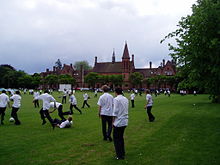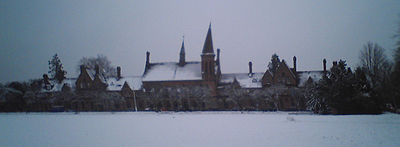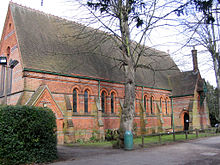- Reading School
-
Reading School Motto Floreat Redingensis Established 1125 (refounded in 1486) Type Academy School Religion Christian Principal J I Weeds Chaplain Rev Chris Evans Specialism Humanities
(English, Classics and Geography)
ScienceLocation Erleigh Road
Reading
Berkshire
RG1 5LW
United KingdomLocal authority Reading Borough Council DfE URN 110097 Ofsted Reports Students 867 Gender Boys Ages 11–18 Houses School :(green, orange, blue)
County :(majenta)
East :(pink/cerise)
West :(yellow/gold)Colours Navy Blue, Silver, House colours. Publication Reading Rag Website www.reading-school.co.uk Reading School is a state-funded, selective academy school for boys in the English town of Reading. It is notable for tracing its history back to the school of Reading Abbey, making it one of the oldest schools in England. There are no tuition fees for day pupils, and boarders only pay for food and lodgings. The current principal, since Autumn 2006, is John I. Weeds.
Contents
History
Reading School was founded as part of Reading Abbey. The date of the Abbey's charter, March 29, 1125, is taken as the foundation date, making it the 10th oldest school in England, although there are hints that there may have been a school running in Reading before this.
In 1486, the school was refounded as a "Free Grammar School" ("free" here meaning teaching the free, or liberal, arts, not that no fees were paid) by Henry VII on the urging of the then Abbot, John Thorne. From at least this time, the School was housed in the former Hospitium of St John. The main building of the hospitium still exists, but the refectory, which once housed the schoolroom, was demolished in 1785 and Reading Town Hall now stands on the site.[1][2]
After the dissolution of Reading Abbey in 1539, the school fell under the control of the corporation of Reading, its status being confirmed by Letters Patent issued by Henry VIII in 1541. This was reconfirmed in the Royal Charter granted to the corporation of Reading by Elizabeth I in 1560, which made the corporation liable for the salary of the headmaster and gave them the power of appointing him.
There were interruptions to schooling in 1665, when Parliament, forced out of London by the Great Plague, took over the schoolhouse. The civil war also interrupted, with the school being used as a garrison by royalist forces. The school prospered at the start of the nineteenth century but by 1866 disagreements between the town and school, which had become increasingly exclusive, and problems with the lease on the school buildings had led to falling numbers and the school closed briefly when (according to legend), the inspectors, on asking to see the school, were told "He's runned away".
The school soon restarted, however, with the Reading School Act (1867) setting out its administration and funding. The foundation stone for new buildings, designed by Alfred Waterhouse, was laid by the Prince of Wales in 1870, and in 1871 the school moved in. In 1915 Kendrick Boys' School (founded in 1875 from the legacy of John Kendrick), which had a large endowment but poor facilities, was taken over by Reading, which was poorly funded but had excellent facilities – this caused considerable controversy at the time but was ultimately seen as successful.
The 1944 Education Act saw the abolition of fees (apart from boarding charges), with the cost of education now being met by the local authority. The 1960s saw the rise of comprehensive education, which threatened Reading's status. However, Reading was exempted in 1973 (along with the girls' grammar school in Reading, Kendrick) after a petition of over 30,000 local people (a third of the voters of Reading) was handed to the government.
In 1986 the school celebrated the quincentenary of its refounding, and was graced by a visit by Queen Elizabeth II. A history of the school by Michael Naxton was published that year by Reading School Parents' Association.
On 6 July 2007 Reading School was officially designated as the landing site for the Thames Valley and Chiltern Air Ambulance when it needs to transport patients to the nearby Royal Berkshire Hospital. Previously, seriously injured or ill patients from the Reading area had to be flown either to Wexham Park Hospital near Slough, or to the John Radcliffe Hospital in Oxford for treatment. The new arrangement means that the school field can now be used for emergency touchdowns. Patients are transported by land ambulance from the school to the hospital's accident and emergency department across the road.[3] While this arrangement was only made official in 2007, the school field had been unofficially used on several occasions by the Thames Valley and Chiltern Air Ambulance in previous years.
School site
The current school site consists of a main block (with two wings), a Science block, the Page building, the John Kendrick building, South House, Music School (formerly known as Junior School) and a chapel. The main school building, the chapel, South House and the building to the east of South House have all been designated as Grade II listed buildings by English Heritage.[4][5][6][7]
The main block consists of 11 teaching rooms, as well as most of the school's administrative rooms. The classrooms here are mainly used to teach English, Economics, Classics, Latin and Ancient Greek; but the two Drama studios are used exclusively for Drama. The block is built around a central quadrangle, with the main teaching rooms down the east side, and the Drama studios to the west. Over the northern entrance to the 'quad' is Big School, the school hall. There are also two wings: East Wing and West Wing. East Wing serves as a boarding house, while West Wing houses the staff room, sixth form common room, administrative entrance and reception, the newly re-named 'Middleton room' (ICT suite) and Religious Studies department.
The Science block, situated on the south-east of the site, contains a workshop for Technology classes, three Physics labs, three Biology labs, three Chemistry labs and a lecture theatre.
South House is a boarding house, although it also contains four teaching rooms and the 'Eppstein room', which functions as a secondary Mathematics office.
The Page Building, located between South House and the Science block, contains two Art rooms, two Technology labs (Graphics and Electronics), three Mathematics rooms, the main Mathematics office and an ICT suite.
The John Kendrick building, opened in 2002, is to the west of the site, housing the Library (formerly the Learning Resources Centre), two Geography rooms, two History rooms and four language classrooms. The adjoined 'Coach House' contains another Geography room, a History room, and two offices.
The chapel is where the school's Christmas and Easter services take place, and every student attends once a week. The chapel has four groups of pews, facing towards the central aisle. Above the entrance is the organ, and at the far end is the altar and vestry.
Music School (formerly Junior School) has a teaching room, an ICT suite, a hall (used for orchestra and choir practices) and four smaller individual teaching rooms (used for individual music lessons). The school is developing an arts area in the unused part of the building. The building is situated at the far end of the drive, on the left of the main entrance.
The school is currently building a modern refectory to provide decent dining facilities for boys. Plans are also being developed for improved sports and science facilities.
Panorama
Inspections and awards
An OFSTED report[when?] concluded that "examination results place the school in the top five per cent nationally", "Pupils' attitudes to learning are outstanding" and "The school goes to exceptional lengths to broaden and enrich the education of all pupils". The 2005 Key Stage 3 results were both the best in the country for value-added and for the average points score of each student.[8] In the 2004 school league tables for England (including fee-paying schools), it came eighth for GCSE-level results (average 602.5 points), 106th for A-level results (average 409.3 points) and 170th for value-added between ages 11 and 16 (score of 1037.7 compared with a baseline of 1000). It has recently become a DFES specialist school for the Humanities, specialising in English[citation needed], Geography and Classics – the first school to specialise in Classics – despite entry being selected by Mathematics and verbal and non-verbal logic ability. The School prides itself on offering A-Level Latin to any student who has an interest in studying the subject. The School will also offer Ancient Greek if numbers permit.
In 2005 the school was awarded the highly prestigious Sportsmark gold award for a four-year period. In the same year Reading was one of just 35 schools nationally to be made a Microsoft Partner School.[9] Reading School has had a partnership with Akhter Computers in Harlow, Essex, since 1998. The company has installed networks throughout the school and in the boarding house. It has also furnished the library with a special system which enables the school to record, edit and distribute video across the network.[10] In 2007, the school was identified by the Sutton Trust as one of only 20 state schools among the 100 schools in the UK responsible for a third of admissions to Oxford and Cambridge Universities over the five preceding years. 16.0% of pupils went to Oxbridge and a 62.1% in total went to universities identified by the Sutton Trust as "top universities".[11]
Reading School was given the prestigious "State School of the Year" award by The Sunday Times newspaper in 2010, in recognition of the school's academic achievements and community orientated ethos.[citation needed]
Subjects taught
Subject Taught at KS3 Taught at GCSE Taught at A level Taught at IB* Classical Greek Taught in KS3 as part of Classics (Compulsory) Yes Yes Yes Art Compulsory Yes Yes Yes Biology Compulsory Compulsory Yes Yes Business Studies No Yes No No Chemistry Compulsory Compulsory Yes Yes Classical Civilisation Taught in KS3 as part of Classics (Compulsory) Yes Yes No Drama Compulsory Yes Yes No Economics No Yes Yes Yes English Compulsory Compulsory Yes Compulsory French Compulsory Yes Yes Yes Geography Compulsory Yes Yes Yes German Compulsory from Year 8 Yes Yes Yes History Compulsory Yes Yes Yes ICT Compulsory No No No Latin Taught in KS3 as part of Classics (Compulsory) Yes Yes Yes Mandarin Chinese No Yes Yes No Mathematics** Compulsory Compulsory Yes Compulsory Music Compulsory Yes Yes Yes Physical Education Compulsory No Compulsory*** No*** Physics Compulsory Compulsory Yes Yes Religious Education Compulsory Compulsory As an extra-curricular option No Spanish No Yes No Yes Technology Compulsory Yes Yes No *Certain subjects offered at IB are liable to change over the coming years due to its new status.
**Additional Maths is taken by some students at the same time as GCSEs. Further Maths is optional at A Level.
***In the sixth form, P.E. can optionally be taken as an examined A-Level. Those that do not do this must still take part in games weekly, though this is not examined or graded in any way, or must take part in Community Service during Games lessons.
Notable headmasters
- c.1540 Leonard Coxe
- c.1555 Julian Palmer (1533–1556) Protestant martyr
- 1716–1750 Haviland Hiley
- 1781–1830 Dr Richard Valpy (1754–1836)
- 1830–1839 Rev. Francis Edward Jackson Valpy, son of Dr Richard Valpy
- 1871–1877 Thomas Henry Stokoe
- 1894–1914 William Charles Eppstein
- 1914–1939 George Keeton
- 1939–1966 Charles Kemp
- 1997–2005 Andrew Linnell
Notable principals
- Mr John I. Weeds 2006-Present; he is the first principal of Reading School
Notable "Old Redingensians" (former students)
Deceased Old Redingensians (chronological order)
Name Year of birth Year of death Notable achievements Sir Thomas White 1492 1567 Founder of St John's College, Oxford and Lord Mayor of London in 1553 Sir Francis Moore 1559 1621 MP for Reading John Blagrave c.1561 1611 Mathematician William Laud 1573 1645 Chancellor of the University of Oxford 1629–1645, Archbishop of Canterbury, 1633–1645, beheaded in 1645 during the Civil War John Kendrick 1573 1624 Elizabethan/Jacobean merchant and philanthropist Daniel Blagrave 1603 1668 Regicide (Signatory of the death warrant of Charles I in 1649). Escaped to exile in Aachen at the Restoration in 1660 Sir Thomas Stampe (or Stamp) Lord Mayor of the City of London in 1691 Sir Constantine Phipps 1656 1723 Lord Chancellor of Ireland Thomas Noon Talfourd 1795 1854 Judge and writer Horace William Wheelwright 1815 1865 Lawyer, hunter, naturalist and writer Captain Hastings Harington 1832 1861 Awarded the Victoria Cross as a lieutenant with the Bengal Artillery for conspicuous gallantry in the relief of Lucknow, 1857; died at Agra Joseph Wells 1855 1929 Warden of Wadham College, Oxford 1913–1927, Vice-Chancellor of the University of Oxford 1923–1926 William Norman Rae 1886 1964 Professor of Chemistry, Royal College of Surgeons in Ireland Herbert Leader Hawkins 1887 1968 Fellow of the Royal Society (elected 1937), President of the Palaeontological Society, Professor of Palaeontology, University of Reading, world authority on sea urchins Arthur Negus 1903 1985 broadcaster and antiques expert Norman Gash 1912 2009 Eminent historian, former Professor of Modern History at the University of St Andrews John Boulting 1913 1985 Film director and producer Horace Edgar "Tom" Dollery 1914 1987 Warwickshire and England Cricketer John Minton 1917 1957 Artist, lecturer and teacher George William Series 1920 1995 Physicist, Professor of Physics, University of Reading, Fellow of the Royal Society (elected 1971) Sir Clifford Charles Butler 1922 1999 Physicist, co-discoverer of hyperons and mesons Living Old Redingensians (alphabetical order)
Name Year of birth Notable achievements Paul Badham 1942 Professor of Theology and Religious Studies, University of Lampeter, Director of the Alister Hardy Religious Experience Research Centre Ross Brawn 1954 Former Technical Director of Benetton and Ferrari Formula 1 teams, former Team Principle of Honda F1, former owner of Brawn GP, Team Principal of Mercedes Grand Prix Tom Burrows 1985 Hampshire County Cricket Club 1st Team Mark Field 1964 MP – Shadow Financial Secretary to the Treasury Cris Freddi 1955 Author Damian Green 1956 Former business editor for Channel 4, MP - Minister for Immigration Oliver Heald 1954 MP – Shadow Constitutional Affairs Secretary Christopher Renshaw 1951 Theatre Director Lord Roper of Thorney Island 1935 Liberal Democrat Chief Whip in the House of Lords Andrew Smith 1952 MP – Former Secretary of State for Work and Pensions and former Cabinet Minister Bibliography
- Michael Naxton. The History of Reading School. Ringwood, Hampshire: Pardy Printers, 1986.
- John Oakes and Martin Parsons. Reading School: The First 800 Years. Peterborough: DSM, 2005. ISBN 0-9547229-2-2.
- John Oakes and Martin Parsons. Old School Ties: Educating for Empire and War. Peterborough: DSM, 2001. ISBN 0-9536516-6-5. (The stories of Old Redingsians in World War I)
- A History of Cricket at Reading School, 1987.
See also
- List of schools in the United Kingdom
- List of the oldest schools in the United Kingdom
- List of the oldest schools in the world
- List of Victoria Crosses by School
- Specialist Schools and Academies Trust
- The Abbey School and Kendrick School, two local schools for girls
References
- ^ Phillips, Daphne (1980). The Story of Reading. Countryside Books. pp. 42. ISBN 0905392078.
- ^ Phillips, Daphne (1980). The Story of Reading. Countryside Books. pp. 88. ISBN 0905392078.
- ^ Reading School – "New Landing Site for Air Ambulance". The South Central Ambulance Service NHS Trust
- ^ Main school building, Images of England reference no. 38922
- ^ Lecture Theatre at Reading School, Images of England reference no. 38923
- ^ South House, Images of England reference no. 38924
- ^ Building to the east of South House, Images of England reference no. 38925
- ^ "Grammar boys are simply the best". Reading Evening Post. 2006-03-30.
- ^ Andrew Linnell. The Headmaster's Letter. The Old Redingensian, May 2005, p2 (PDF).
- ^ Case Study. Video Broadcast over the Network at Reading School (PDF)
- ^ (PDF) University Admissions by Individual Schools. Sutton Trust. 2007. http://www.suttontrust.com/reports/UniversityAdmissionsbySchool.pdf
External links
- Reading School
- Reading School Parents' Association
- Old Redingensians
- School overview and profile from Schoolsfinder
Grade I Grade II* Reading Abbey · Reading Town Hall · Royal Berkshire Hospital · St Mary's Church, Castle Street · St Peter's Church · Watlington HouseGrade II Abbey Mill, Reading · All Saints' Church · Bath Road Reservoir · Battle Library · Broad Street Independent Chapel · Brock Barracks · Caversham Park · Coley Park · The Forbury Hotel · Foxhill House · High Bridge · Highdown School · Kendrick School · King's Meadow swimming pool · Leighton Park School · Maiwand Lion · Malmaison Hotel · New Town Primary School · Prospect Park · Queen Anne's School · Reading Old Cemetery · Reading railway station · Reading School · St Giles' Church · St James's Church · Reading Town Hall · Vachel Almshouses · Wantage HallCategories:- Grade II listed buildings in Reading
- Grammar schools in Berkshire
- Humanities Colleges in England
- Old Redingensians
- Schools in Reading, Berkshire
- Educational institutions established in the 12th century
- Schools with Combined Cadet Forces
- 1125 establishments
- Boys' schools in Berkshire
- Alfred Waterhouse buildings
- Foundation schools
- Grade II listed educational buildings
- 12th-century establishments in England
Wikimedia Foundation. 2010.





